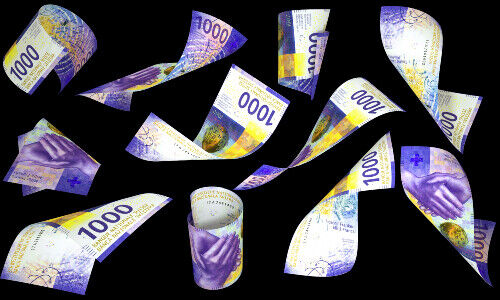When seeking hard currencies, one almost inevitably thinks of the Swiss franc. Major currencies have all lost value against the franc this millennium. Why?
There are many reasons for the strength of the franc. Switzerland is economically strong with a large current account surplus, which boosts demand for the franc. Its current account surplus has been at least five percent of gross domestic product (GDP) in 20 of the past 23 years.
A positive current account balance alone doesn't make a hard currency, as Norway shows, which is in an even stronger position, with an average surplus of 12 percent of GDP since 2000. At the same time, the Norwegian krone depreciated by around 30 percent against the euro over the same period. So what is behind the strength of the franc?
Safe Haven

Julian Marx, Research Analyst at Flossbach von Storch (Image: FvS)
Above all, the franc's status as a safe haven is responsible, explains Julian Marx (pictured above), Research Analyst at Cologne-based asset manager Flossbach von Storch, which also has a presence in Zurich. As early as the 1920s, the franc was characterized by monetary and political stability, while in many other countries, the de facto abandonment of a metal-based currency system was regularly exploited to finance the state.
This reputation, acquired over decades, still reverberates today. Investors' desire for currency stability is expressed in the foreign exchange investments of the Swiss National Bank (SNB).
Genuine Hard Currency
Through the first quarter of last year, the SNB acquired foreign currencies worth over 900 billion francs to alleviate appreciation pressure on the domestic currency.
Since then, interest rates abroad have risen faster than in Switzerland and the SNB has been able to reduce its foreign currency holdings by more than 100 billion francs.
Losing Versus the Swiss Franc
«As long as Switzerland as a business location can maintain its high productivity and the status of the franc as a safe haven continues, the Swiss currency will probably remain a real hard currency for many years to come,» Marx explains.
But what about the major currency areas of industrialized nations? Can they still be called hard currencies? «A clear judgment is difficult,» says Marx, «because the euro, dollar, and yen all have individual construction sites.»
The eurozone lives with the innate design flaw of economic heterogeneity among member states. The dollar enjoys safe haven status by being the world's reserve currency. However, such status is not set in stone in an increasingly polarized world.
Search for Alternatives
In this respect, a chronic current account deficit, such as the one in the US, should by no means be ignored. The US economy hasn't been able to generate a current account surplus for 30 years, which, viewed in isolation, should argue against a structural appreciation of the dollar.
There is no major currency area that can convince across the board, and the search for alternatives is proving difficult. The Chinese renminbi doesn't suggest itself, although China's economic performance and the attractiveness of its markets are undisputed.
What's the Renminbi Worth?
But there, any investment is dependent on the will of autocratic leadership. Given the experience of recent years with deteriorating legal certainty, China may find it increasingly difficult to establish the renminbi as an alternative reserve currency to the dollar, even in the Western world.
«At the end of the day, with the euro, the dollar, and the yen, we are still talking about three thoroughly powerful currency areas,» Marx says. With only ten percent of the world's population, they generated almost 44 percent of global economic output last year, and their currencies are extremely liquid due to their economic size and usage patterns.
«Hard Soft Currency»
This is particularly true of the euro and dollar. Around 60 percent of global foreign debt was denominated in dollars at the end of 2021, and around 20 percent in euros. A look at foreign exchange reserves and international payment transactions also indicates a leading use of the two currencies.
The euro can't be a hard currency in the sense of the Deutschmark simply because of its design flaws, but can perhaps be viewed as something of a «hard soft currency» for lack of significantly better alternatives.



































